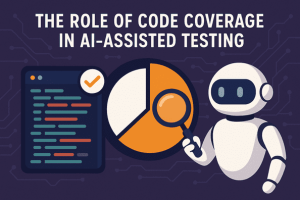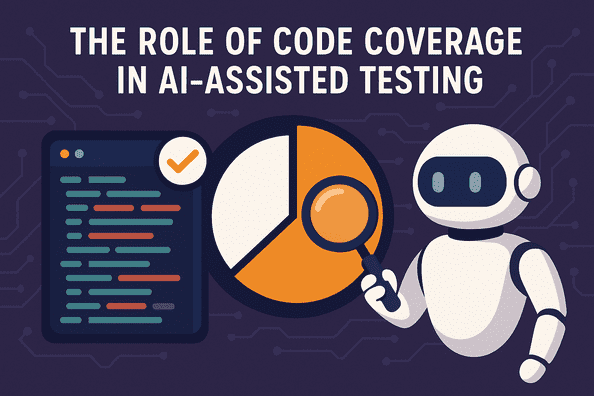As software development evolves, the combination of artificial intelligence (AI) and testing automation is changing how teams measure quality. Traditional metrics like code coverage have long been used to gauge how much of the source code is exercised by tests—but as AI-driven testing becomes more sophisticated, the meaning and utility of this metric are also being redefined.
Today, the question isn’t just “how much of the code is covered?” but rather “are we testing the right parts of the code, and what can AI tell us about what’s missing?”
Understanding the Foundation: What Code Coverage Really Means
Code coverage measures the percentage of source code executed during testing. It identifies which parts of an application’s logic are being tested—and more importantly, which parts are not. Common types include:
Statement coverage: Verifies that each line of code runs at least once.
Branch coverage: Ensures that all possible branches (if/else conditions) are tested.
Function coverage: Confirms that all defined functions are executed.
Path coverage: Measures how many potential execution paths are tested.
Traditionally, teams aimed for higher percentages—often targeting 80–90% coverage—as an indicator of robust testing. However, the reality is more nuanced. High code coverage doesn’t always mean high-quality tests; you can test every line and still miss logical flaws or real-world scenarios.
The Emergence of AI-Assisted Testing
AI-assisted testing uses machine learning and intelligent automation to generate, optimize, and maintain tests dynamically. Instead of relying solely on manually written scripts, AI-driven tools learn from code changes, user behavior, and past test results to determine where and how to test more effectively.
This new paradigm helps teams overcome some of the biggest challenges in traditional testing—like identifying redundant tests, predicting risky areas, and maintaining coverage across frequent code changes.
AI can analyze repositories, commits, and runtime data to identify untested or under-tested code paths. It can then automatically generate new test cases or suggest improvements based on historical patterns.
How Code Coverage Fits into AI-Assisted Testing?
In an AI-assisted testing environment, code coverage becomes more than just a number—it becomes a data signal that guides machine learning models. Here’s how it works in practice:
Smart Coverage Analysis
AI tools can interpret coverage data alongside defect trends and user analytics to determine which areas of the code are both critical and vulnerable. This helps prioritize testing where it matters most, instead of chasing arbitrary coverage percentages.
Adaptive Test Generation
By integrating with coverage tools, AI systems can automatically create new test cases for uncovered code segments. For example, if a module shows low branch coverage, an AI agent can generate inputs that trigger untested conditions, filling those coverage gaps.
Self-Optimizing Test Suites
Over time, AI systems learn from execution patterns to eliminate redundant or low-value tests. This reduces test suite bloat, speeds up execution, and ensures that coverage remains meaningful rather than inflated.
Predictive Quality Insights
When combined with code coverage metrics, AI-driven analytics can forecast areas of potential regression risk—helping teams focus testing efforts on components that are both under-tested and historically unstable.
The Benefits for Developers and QA Teams
Integrating AI with code coverage data offers several tangible advantages:
Improved Efficiency: Developers spend less time writing and maintaining repetitive tests, while AI ensures comprehensive coverage automatically.
Higher Accuracy: AI identifies untested logic branches and edge cases that humans may overlook.
Reduced Maintenance Overhead: When code changes, AI can adjust existing tests to reflect new logic, maintaining consistent coverage.
Smarter Prioritization: Instead of running every test on every build, AI can select tests based on impact and risk analysis—improving feedback loops in CI/CD pipelines.
How Tools Like Keploy Are Advancing This Space?
Open source solutions like Keploy are redefining how code coverage interacts with intelligent automation. Keploy automatically captures real user interactions at the API level and converts them into deterministic test cases and mocks. This approach ensures that tests reflect real-world usage, improving both functional accuracy and effective coverage.
Unlike traditional test frameworks that focus solely on line or branch metrics, Keploy’s methodology bridges the gap between observed behavior and coverage data—giving developers a more holistic view of quality. By combining automation with actual usage insights, it enhances both productivity and reliability across modern QA workflows.
Challenges and Considerations
Despite its advantages, AI-assisted testing with coverage data isn’t without challenges. For one, AI systems rely heavily on accurate and consistent coverage metrics; if the underlying data is incomplete or misinterpreted, the resulting insights can be misleading.
Additionally, AI models must be transparent and explainable. Developers need to understand why a particular test was generated or optimized to ensure accountability and trust in the automation process.
Finally, organizations must resist the temptation to treat coverage as the sole indicator of quality. AI can optimize coverage intelligently, but it can’t replace human intuition in understanding business logic and user experience.
The Future of Code Coverage in Intelligent Testing
As AI continues to mature, code coverage will evolve from a static metric into a dynamic, data-driven quality signal. Instead of being used to measure test completeness alone, it will serve as a feedback mechanism that continuously improves testing strategy and automation efficiency. In this future, QA teams won’t aim for “100% coverage” as a vanity goal. Instead, they’ll focus on effective coverage—the meaningful validation of critical, high-risk, and user-facing parts of their applications.
AI-assisted testing, when paired with actionable coverage insights, will enable teams to test smarter, release faster, and build more resilient systems. The takeaway is clear: code coverage isn’t going away—it’s becoming more intelligent, contextual, and impactful than ever before.
 :
https://in.pinterest.com/
:
https://in.pinterest.com/












